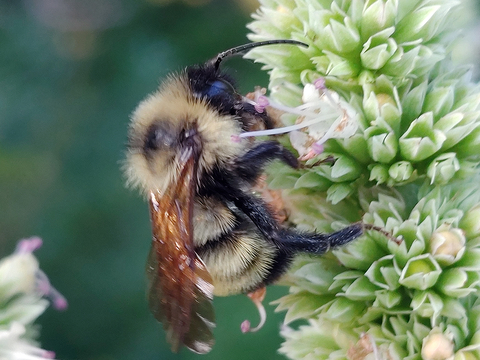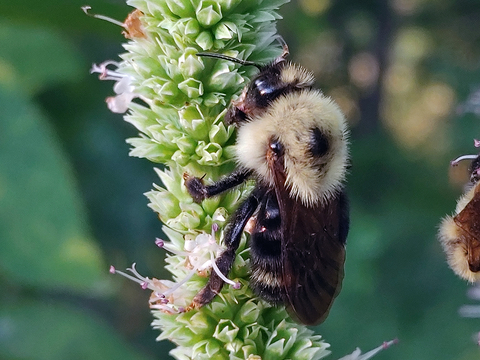Late summer to early fall is a great time of year to observe bumble bees. Sunflowers and goldenrods are still blooming and buzzing with activity.
A few months ago, I spotted dozens of bumbles feasting on a purple giant hyssop patch. This type of native hyssop tends to be in woodlands and provides many long-lasting flowers for insects.
Several bumble bee species were easy to identify, including quite common ones such as the eastern, two-spotted, and brown-belted bumble bees. However, two caught my eye. One bee was very large, dwarfing the other bees as well as a few Japanese beetles. The other was densely hairy, with as much yellow on it as the goldenrod nearby. To my surprise, they were the same species, the lemon cuckoo bumble bee.
Nest thieves
Lemon cuckoo bumble bees belong to a group of bumble bees that have a very different life strategy compared to most of their bumble relatives. Instead of creating a colony, female cuckoos take over the nests of other bumble bees. Nest takeovers are not uncommon among bumble bees. It can be hard to find the perfect place to make a nest and it is sometimes worth the risk to fight the original owner over one.
Cuckoo bumble bees are different because they are 100% committed to nest takeovers. There are three features that lock them into this behavior:
- Cuckoo bumble bees lack corbiculae, or pollen baskets on their legs for pollen collection. This makes it very hard to bring food to a nest.
- There is no such thing as a worker cuckoo bumble bee. They can only make queens (females) or drones (males).
- The females make little wax to build proper cells or honey pots for their young.
Scientists classify cuckoo bumble bees as "obligate socially parasitic." This means cuckoo bumble bees cannot complete their life cycle without stealing food and labor from other bee colonies. Some of their favorite targets include eastern common, half-black, and two-spotted bumble bees, all of which are common in Minnesota.
How do these bees capture a nest?
Female lemon cuckoo bees are well-equipped for combat. Nastier stingers, bigger mandibles, and a larger size give them a natural advantage over other bumble bee species. They are not invincible, however, and lemon cuckoos can be occasionally defeated by a nest.
After killing a host queen and possibly some of her workers, a lemon cuckoo bumble bee then bullies the survivors with aggressive physical behaviors and scent marking. Soon afterward, this cuckoo female destroys the eggs and larvae of her predecessor and lays her own (up to twice as many eggs as other bumble bees), which the captive workers eventually help rear.
In general, it is thought the more host bumble bee nests there are, the larger a lemon cuckoo’s population gets. In that sense, it is like a predator-prey relationship — there are boom and bust cycles.
Sometimes cuckoo bumble bees can be very good at their job. A 2003 Quebec study looking at food availability for eastern common and tricolored bumble bees had one year where every nest they set up (save one) was taken over by cuckoo bees.
Not all cuckoo bees thrive
While lemon cuckoo numbers are considered stable, that is not always the case for other socially parasitic bumble bees. Many of the bumble bees most at risk of extinction are cuckoo bumble bees.
Ashton’s cuckoo bumble bee, for example, preys on rusty patched bumble bee nests as well as the yellow banded bumble bee. As these hosts are endangered or vulnerable, respectively, the Ashton’s cuckoo population is thought to have undergone a huge reduction over the last few decades. As little historical data exists about the Ashton’s cuckoo bee (there is a debate as to whether it is really its own species), there are lots of valid questions regarding how bad the situation is for these unusual types of parasitic bumble bees.
Predator bees can be signs of a healthy habitat
But why should we care much about cuckoo bumble bees like the lemon or Ashton’s who kill effective pollinators? Fortunately, cuckoo bumble bees are not thought to be responsible for serious population declines in bees.
Aside from the loss of biodiversity, which is beyond the scope of this short article, cuckoo bumble bees have important functions in our ecosystem. By controlling their hosts’ numbers, other types of pollinators can continue to compete effectively for resources. It is easy to forget that pollen and nectar are not infinitely available in landscapes. Also, strong hives that resist invading cuckoo bumble bees could produce additional strong offspring.
So, the next time you see a beefy lemon cuckoo zooming around, please leave it alone. Having these animals in your landscape is a good sign of a quality habitat and functioning nature.
Interested in learning more about caring for bumble bees? Check out the book, "Befriending Bumble Bees: A practical guide to raising local bumble bees." Co-written by our native bee Extension educator, Elaine Evans, the newest edition even has a chapter devoted to cuckoo bumble bees. You can order it from Amazon or the UMN Bookstore (coming soon).
Dozier, A. E., Straw, E. A., & Stanley, D. A. (2023). Systematic review of cuckoo bumble bee research reveals data gaps and understudied species. Ecological Entomology.
Lhomme, P., & Hines, H. M. (2019). Ecology and evolution of cuckoo bumble bees. Annals of the Entomological Society of America, 112(3), 122-140.
Pelletier, L., & McNeil, J. N. (2003). The effect of food supplementation on reproductive success in bumble bee field colonies. Oikos, 103(3), 688-694.



